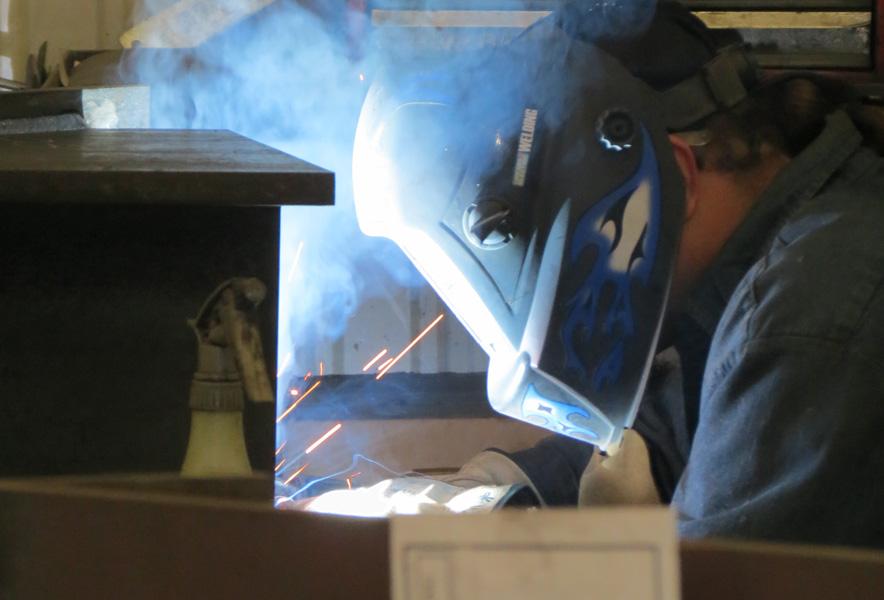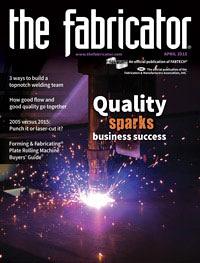Senior Editor
- FMA
- The Fabricator
- FABTECH
- Canadian Metalworking
Categories
- Additive Manufacturing
- Aluminum Welding
- Arc Welding
- Assembly and Joining
- Automation and Robotics
- Bending and Forming
- Consumables
- Cutting and Weld Prep
- Electric Vehicles
- En Español
- Finishing
- Hydroforming
- Laser Cutting
- Laser Welding
- Machining
- Manufacturing Software
- Materials Handling
- Metals/Materials
- Oxyfuel Cutting
- Plasma Cutting
- Power Tools
- Punching and Other Holemaking
- Roll Forming
- Safety
- Sawing
- Shearing
- Shop Management
- Testing and Measuring
- Tube and Pipe Fabrication
- Tube and Pipe Production
- Waterjet Cutting
Industry Directory
Webcasts
Podcasts
FAB 40
Advertise
Subscribe
Account Login
Search
Quality shines bright at MACO
How collaboration and craft make a job shop unique
- By Tim Heston
- April 7, 2015
- Article
- Shop Management
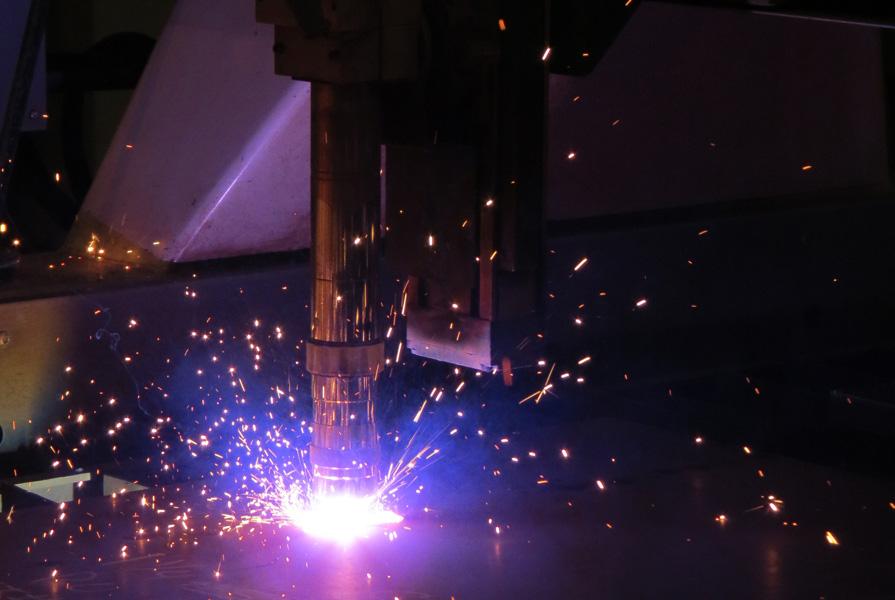
Figure 1
MACO’s new plasma cutting system performs a pierce.
Thanks to recent revenue growth, the company has
added new machines and people. Much of that growth
hinges on the company’s quality systems and approach
to training.
At more custom fabricators, flexible fixturing and offline simulation have made automation possible even for seemingly high-product-mix, low-volume work. It’s not unusual to see a technician switch out a flexible base plate in a robotic welding cell, call up a program, make a few quick adjustments, and let the robot weld only a few dozen parts before the next changeover,
But a quick look at MACO Incorporated’s shop, and it’s easy to see that such automation wouldn’t fit. The Shelby, N.C., company is one part industrial fabricator, one part structural fabricator, one part machine shop, with a dash of field fabrication mixed in for good measure. Outside of some structural beam work, most jobs don’t have enough volume to warrant automation. The shop’s success depends on hands-on skill that can take years to develop.
Tour MACO one day and you’ll see people brazing a small workpiece in one room, other people arc welding a large pressure vessel in the next. The next day you might see people working on a process piping skid, and in the next room others are bending and welding a small tube and bracket assembly, the kind you’d see in a precision sheet metal shop, not an industrial fabricator.
Then in another bay, workers may be assembling test lifting lugs used in nuclear power plant construction. Consisting of extremely thick plate and a pin more than a foot in diameter (yes, diameter, not length), the lifting lugs are designed to withstand more than a half-million pounds of force. MACO has fabricated components like these in the past, but for this job, it’s coordinating the pull-test services, prepping each lug to be sent to a pull-test site in Atlanta.
Delicate brazing and small-tube bending next to structural mezzanine welding next to pipe skid assembly next to inspecting lifting lugs for nuclear power plants—this isn’t your typical job shop (see Figures 1-3).
The company can’t be pigeonholed, and therein lies its competitive advantage, at least in part. But since the recession, managers realized they needed to focus on another, even more important competitive component. This comes to the fore when Todd Melton, company president, visits a prospective customer. The prospect often hands him not a print, but a napkin sketch or an actual part and asks, “Can you build me something like this?” That’s MACO’s sweet spot, something Melton refers to as “fabrication services,” and his voice puts the emphasis on services.
This sweet spot has put the 94-person shop on a growth path, and managers expect growth to continue over the next three to five years. More manufacturing and processing plants are moving into the area. Nuclear plants are being built. A tire plant will be opening its doors. The company installed a temporary structure to handle all the work, and it’s planning to break ground on an expansion later this year (see Figure 4).
MACO hired 30 people last year alone. That’s saying something considering it employed only 28 during the depths of the recession, a time when Melton and his father, who founded the business in the 1980s, wondered if the company would make it.
“We were rotating staff,” Melton said. “Certain weeks we’d have only about 10 to 12 people working. We had time off, short days, and during a lot of those days in 2008 and 2009, it was touch and go. We kept asking ourselves, ‘Are we going to be here?’ So we went back to our roots, and at the same time reinvented ourselves as a service-based business.”
If revenue growth is a guide, the strategy worked. The company made $5 million in 2013, $9.9 million in 2014, and this year managers expect sales to exceed $12 million. That’s not bad for a shop that six years ago was hanging on for dear life.
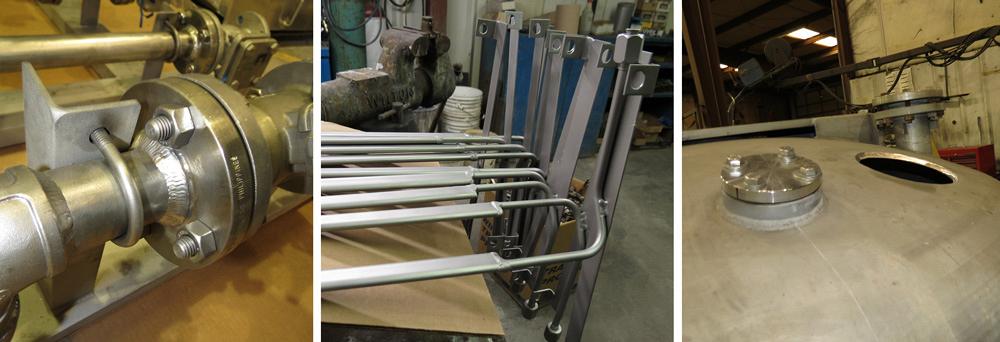
Figure 2
MACO has a unique product mix, from process piping to small-tube bending and bracketry to vessel fabrication and repair.
History of Reinvention
Melton’s father, Michael Melton, launched MACO out of a 20- by 30-ft. cinderblock shack near his house in 1979. He had been a maintenance mechanic for one of the area’s textile mills, and fabricated parts on the side. Back then it was hard not to know people who had some connection with some type of processing plant, textile or otherwise. People he knew kept bringing him work, so he soon quit his full-time job to run MACO full-time.
Over the years the shop expanded into structural and heavy industrial fabrication. Work in rural western North Carolina continued to boom, and MACO filled this need, as did other fabricators. This last point was a harbinger, though. In the 1990s MACO served as a straightforward fabricator and machine shop, and it produced essentially what everybody else could produce. It had no quality certifications, and neither did any other local fabricator. That was the harbinger: From the customer’s point of view, MACO wasn’t much different from anyone else.
What Makes Us Unique?
In the early 2000s MACO was too busy to worry about being unique. In fact, there was so much work that it moved forward with major investments in early 2008. Managers decided to add on to the building and purchase a new Peddinghaus beam drill line and a Wheelabrator blast cleaning machine. The move made sense. “Between 2004 and 2006, there was real money to be made in commercial steel,” Melton said.
Then in late 2008, the bottom fell out of the economy. Melton can laugh about it now (“Yeah, bad timing”) because at the time the management team looked at their options. They didn’t take cover and just hope for the business to return. They could have thrown their hands up and seen themselves as victims of the Great Recession. Instead, they took action.
First, they analyzed what got MACO to where it was. It had grown from a very small operation to a 65-person shop; it added on to its building and bought equipment. All these investments added capacity, but it didn’t make the shop unique.
What did make MACO unusual (though not necessarily unique) was its reach. In the 1990s most customers were within only a 20-mile radius. There was enough business for everybody, but managers also realized that they were caught in a competitive battle. MACO had razor-thin margins for much of its work. That suppressed wages, which in turn made it difficult to find and keep employees.
This changed in the early to mid-2000s, when the company expanded its reach beyond Cleveland County. “The industrial and manufacturing plants in this area were all shrinking,” Melton recalled. “They were all going offshore.” So instead of there being enough work for everybody, “it became a cutthroat business that drove wages down. So that’s when we started to expand beyond Cleveland County and become a regional shop.”
“We went from a 20-mile radius to a 200-mile radius,” said Rod Rockwell, senior project manager.
Throughout the 2000s, managers sold the company’s capabilities and capacity. It had (and still has) an unusual mix of machinery and capabilities: manual and CNC milling and turning, as well as industrial and structural fabrication. Then came the recession, a severe drop in orders, and introspection. At that time, Melton recalled, managers felt they needed something else to set the company apart.
“We asked, ‘How do we sell ourselves?’ This is where attaining quality certifications came into the picture.”

Figure 3
This lifting lug, used for nuclear power plant construction, has a pin that’s more than a foot in diameter. MACO has fabricated components like this, but for this job it’s coordinating the pull-test services, prepping each lug to be sent to a pull-test site in Atlanta.
Training for Service
ome fabricators in the area just didn’t make it through the downturn. As Larry Ledford, project manager, recalled, “When we made our big [quality initiative] change in 2008, a lot of other shops didn’t stay ahead of the curve, and they lost their customer base. They had to downsize.”
This gave MACO a greater share of the market, for sure, but it was still a shrinking market. Work didn’t just come in the door anymore. Still, after area fab shops shut their doors, more experienced people entered the labor pool, and the shop’s recently instituted quality systems helped bring talent up to speed. Entry-level workers shadow veterans and are encouraged to practice. Generally, the more they practice, the faster they can climb the ladder.
Many customers don’t have part fabrication or design as a core competency. They may need a component or two once in a blue moon, so they come to MACO with a request for help—no drawing, no spec sheet, just a problem that needs a solution. Such service epitomizes the nature of the job shop. Give a fabricator a napkin sketch, and he’ll make you what you need. Not every MACO customer does this, of course, but a fair number of them do. And they need only a little at a time. This in turn sends a wide mix of jobs to the floor every day.
So how do you hire and train people for such a job? Slowly and methodically. The company’s training system, based in part on the quality systems in place, have helped institute some structure for getting people up to speed. As soon as a welder becomes qualified in another process, position, or code, his or her pay increases.
“I tell entry-level welders, every position and every weld test is worth more money,” Melton said. “That gives them an incentive. The next time an evaluation comes up, you’ll see them welding at lunch and practicing. We feel it takes them four years in our business to get somebody from that entry-level part up to what we’d call a top-paid welder or fabricator, at which point they’ve seen it all.”
He conceded that this can be frustrating for some people just getting their start in the work world. High wages don’t come overnight, but they do come to those who put in the time and work. Melton described one employee who climbed the ranks from entry-level helper to star welder in just two years. His secret was practice. Every break time, he had the welding gun out to perfect a new welding position or technique.
“As our quality manager says, there’s a big difference in being certified and being qualified,” Melton said. “Yes, you can pass the welding test to get the job, but you’ve got to put it in practice. You’re now welding 4 inches off the ground, and the next thing you know you’re welding the top of a large structure.”
About the Craft
In a contract fabrication situation, part flow occurs a certain way: from cutting to bending to welding. Definitions for that flow can be standardized, procedures written, work instructions documented—all make training easier.
MACO documents its work instructions and procedures too; the shop wouldn’t have the certifications it does without doing so. But the core of its work is tactile, involving the interaction between the worker and the workpiece. MACO documents what needs to be done in WPSs and elsewhere, but a lot of the quality hinges on knowing the human behind the welding gun.
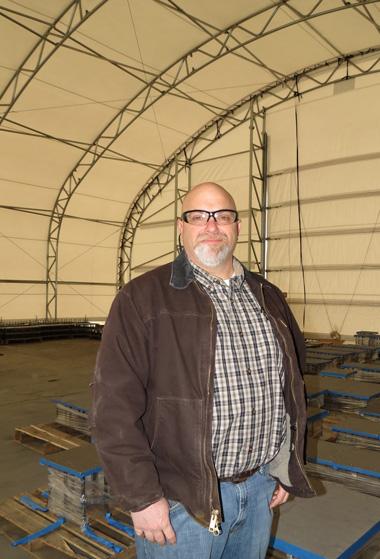
Figure 4
President Todd Melton stands in a temporary structure the company is using until it completes its building expansion, slated to break ground later this year.
For instance, Melton described a large industrial job involving a lot of flange-to-flange and other welding, some of which required X-ray inspection. Certain components needed to be within 0.030 in., a tight tolerance considering the size and nature of the work, which entailed mitigating weld shrinkage. Six welders tackled the job, but the supervisor worked with each to set the job up a certain way. One welder’s joints were fitted up in a slightly different position. That’s because the supervisor knew how each person welded, including how fast. If a person welded at a different speed, he input a different level of heat into the part, and so the joint drew back by a different amount.
“He knew that each welder was going to put in a little more heat or a little less,” Melton said, so the supervisor set the piece up to accommodate.
The result: The piece drew back just the right amount, so the assembly was well within tolerance. The supervisor also knew how fast each welder was most comfortable traveling along the joint. When they were most comfortable, they produced their best work, with few if any weld defects.
If this were a production environment, it would make sense to force workers to conform their welding technique to the job, invest in positioning devices for better weld access, and perhaps even automate certain aspects, Melton said. But these welders didn’t work on thousands of these assemblies, just a few hundred over four months.
Sources emphasized that this was an extreme example. Regardless, welders produce extremely consistent joints. Melton cited a massive pipe skid project that involved 1,180 welds. The job required 100-percent X-ray inspection on all butt-joint welds, and the welders finished it all with only a 2 percent reject rate.
But the previous example proves how a supervisor and front-line employees work together to produce the best result. Everyone knows how everyone else works best, and this kind of connection and collaboration is unique. That connection really can’t be copied.
About the Author

Tim Heston
2135 Point Blvd
Elgin, IL 60123
815-381-1314
Tim Heston, The Fabricator's senior editor, has covered the metal fabrication industry since 1998, starting his career at the American Welding Society's Welding Journal. Since then he has covered the full range of metal fabrication processes, from stamping, bending, and cutting to grinding and polishing. He joined The Fabricator's staff in October 2007.
Related Companies
subscribe now

The Fabricator is North America's leading magazine for the metal forming and fabricating industry. The magazine delivers the news, technical articles, and case histories that enable fabricators to do their jobs more efficiently. The Fabricator has served the industry since 1970.
start your free subscription- Stay connected from anywhere

Easily access valuable industry resources now with full access to the digital edition of The Fabricator.

Easily access valuable industry resources now with full access to the digital edition of The Welder.

Easily access valuable industry resources now with full access to the digital edition of The Tube and Pipe Journal.
- Podcasting
- Podcast:
- The Fabricator Podcast
- Published:
- 04/30/2024
- Running Time:
- 53:00
Seth Feldman of Iowa-based Wertzbaugher Services joins The Fabricator Podcast to offer his take as a Gen Zer...
- Industry Events
Pipe and Tube Conference
- May 21 - 22, 2024
- Omaha, NE
World-Class Roll Forming Workshop
- June 5 - 6, 2024
- Louisville, KY
Advanced Laser Application Workshop
- June 25 - 27, 2024
- Novi, MI
Precision Press Brake Certificate Course
- July 31 - August 1, 2024
- Elgin,
























